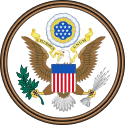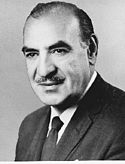Kabinett Kennedy
| Kabinett Kennedy | |
|---|---|
| Regierung der Vereinigten Staaten | |
 | |
| Präsident | John F. Kennedy |
| Wahl | 1960 |
| Legislaturperiode | 87., 88. |
| Bildung | 20. Januar 1961 |
| Ende | 22. November 1963 |
| Dauer | 2 Jahre und 306 Tage |
| Vorgänger | Kabinett Eisenhower |
| Nachfolger | Kabinett Lyndon B. Johnson |
| Zusammensetzung | |
| Partei(en) | Demokratische Partei |
| Minister | 10 |
| Wahl im Electoral College | |
| 1960 | 303/537 |

John F. Kennedy trat am 20. Januar 1961 das Amt des Präsidenten der Vereinigten Staaten an und war der erste Katholik, der in das höchste Staatsamt der USA gewählt wurde. Am 22. November 1963 wurde er in Dallas auf offener Straße erschossen. Der bisherige US-Vizepräsident Lyndon B. Johnson wurde qua US-Verfassung automatisch neuer US-Präsident.
Eine Besonderheit von Kennedys Kabinett war, dass der Demokrat Kennedy mit Finanzminister C. Douglas Dillon und Verteidigungsminister Robert McNamara zwei Republikaner berief. Personelle Umbesetzungen blieben während seiner fast dreijährigen Präsidentschaft die Ausnahme.
Mehrheit im Kongress
| Präsident | Kongress | Haus | Senat | Gesamt | ||||
|---|---|---|---|---|---|---|---|---|
| John F. Kennedy (D) | 87. | 264/435 | 64/100 | Unified government | ||||
| 88. | 259/435 | 66/100 | ||||||
| Quelle: Repräsentantenhaus, Senat | ||||||||
Das Kabinett
Literatur
- Arthur M. Schlesinger: Robert Kennedy and his times. Ballantine Books, Boston 1978, ISBN 0-345-32547-8, S. 222–236.
Weblinks
- John F. Kennedy – Administration. Miller Center of Public Affairs der University of Virginia (englisch, Redakteur: Marc J. Selverstone)
Auf dieser Seite verwendete Medien
John A. Gronouski, U.S. Postmaster General and Ambassador to Poland.
President John F. Kennedy (in rocking chair) meets with Administrator of the Agency for International Development (AID), David E. Bell (left), and Chairman of the Committee to Strengthen the Security of the Free World, General Lucius D. Clay. Oval Office, White House, Washington, D.C.
- Scope and content: Swearing-In Ceremony of President Kennedy's Cabinet. Chief Justice Earl Warren administers Oath to (L-R) Dean Rusk, Sec. State, Douglas Dillon, Sec. Treasury, Robert S. McNamara, Sec. Defense, Robert F. Kennedy, Attorney General, J. Edward Day, Postmaster General, Stewart Udall, Sec. Interior, Mrs. Kennedy, President Kennedy, Adlai E. Stevenson, Representative to the U.N., Orville Freeman, Sec. Agriculture (hidden: Luther Hodges, Sec. Commerce) Arthur Goldberg, Sec. Labor, Abraham Ribicoff, Sec. Health, Education & Welfare. ( In rear: Gen. C.V. Clifton, Military Aide, Col. Godfrey McHugh, Air Force Aide, Cmdr. Tazewell Shepard, Naval Aide ) White House, East Room.
United States President John F. Kennedy addresses the nation on civil rights via television, speaking from the Resolute desk in the Oval Office of the White House.
Secretary of Defense Robert McNamara at the Cabinet Room, White House, Washington, DC
Robert Kennedy appearing before Platform Committee
C. Douglas Dillon, U.S. Secretary of the Treasury. This picture was taken in 1955 in Dillon's capacity of Ambassador to France. The caption information for this image can be seen here, provided by Still Picture Reference Team at the National Archives and Records Administration. The identifier for this image is PAR 7117.
Guests at White House Correspondents' Association Dinner
Picture of John F. Kennedy
W. Willard Wirtz
Photo portrait of President Lyndon B. Johnson in the Oval Office, leaning on a chair.
Anthony J. Celebrezze (1910-1998), Secretary of HEW.
Kermit Gordon, Director of the United States Bureau of the Budget. Photograph from the Kermit Gordon Papers in the John F. Kennedy Presidential Library and Museum, Boston.
Orville L. Freeman, Secretary of Agriculture (1961-1969). Photograph in the John F. Kennedy Presidential Library and Museum, Boston.





































